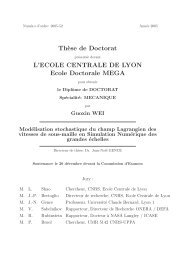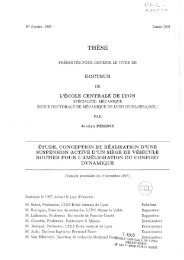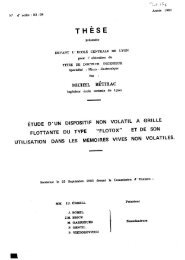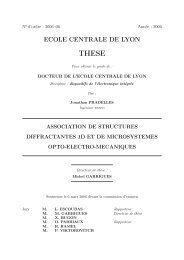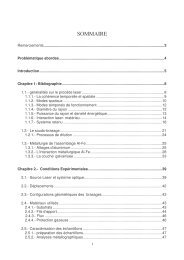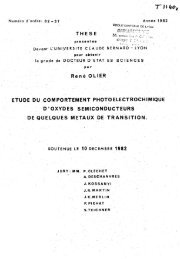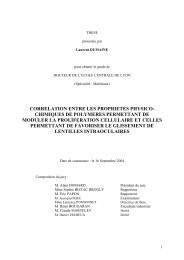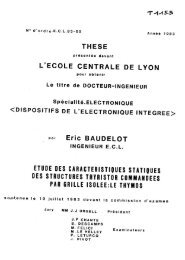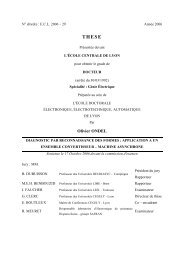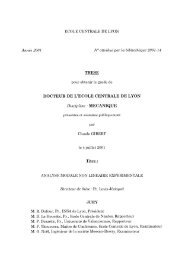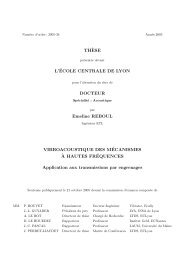MR thèse 2006-21 - Bibliothèque Ecole Centrale Lyon
MR thèse 2006-21 - Bibliothèque Ecole Centrale Lyon
MR thèse 2006-21 - Bibliothèque Ecole Centrale Lyon
Create successful ePaper yourself
Turn your PDF publications into a flip-book with our unique Google optimized e-Paper software.
SOMMAIRE<br />
INTRODUCTION GENERALE<br />
CHAPITRE I : LES ATNC, UN PROBLEME DE SANTE PUBLIQUE<br />
I. GENERALITES...........................................................................................................................- 6 -<br />
I.1. LE PRION : LE GENE PRNP PROTEINE PRION CELLULAIRE ET PROTEINE PRION PATHOLOGIQUE - 7<br />
-<br />
I.1.1. Le gène PRNP..................................................................................................................- 7 -<br />
I.1.2. La protéine prion cellulaire PrPc....................................................................................- 8 -<br />
I.1.3. La protéine prion pathologique PrPsc.............................................................................- 9 -<br />
I.2. LES MALADIES HUMAINES A PRIONS .................................................................................... - 11 -<br />
II. LES RISQUES POUR LA SANTE PUBLIQUE .....................................................................- 14 -<br />
II.1. LES PATIENTS A RISQUE....................................................................................................... - 14 -<br />
II.2. LES TISSUS A RISQUE ........................................................................................................... - 16 -<br />
II.3. LES ACTES A RISQUE............................................................................................................ - 16 -<br />
II.4. INACTIVATION DES ATNC................................................................................................... - 17 -<br />
III. LE TRAITEMENT DES DISPOSITIFS MEDICAUX REUTILISABLES : CAS<br />
PARTICULIER DES ENDOSCOPES SOUPLES THERMOSENSIBLES ...................................- 18 -<br />
III.1. LE PRETRAITEMENT OU PRE-DESINFECTION......................................................................... - 19 -<br />
III.2. LE DOUBLE NETTOYAGE ...................................................................................................... - 19 -<br />
III.3. LE RINÇAGE INTERMEDIAIRE ............................................................................................... - 19 -<br />
III.4. LA DESINFECTION................................................................................................................ - 20 -<br />
III.5. LE RINÇAGE FINAL............................................................................................................... - 20 -<br />
IV. LE NETTOYAGE .................................................................................................................- <strong>21</strong> -<br />
IV.1. LES MECANISMES DE LA DETERGENCE................................................................................. - <strong>21</strong> -<br />
IV.2. LES CARACTERISTIQUES DES FORMULATIONS NETTOYANTES ET/OU PRE-DESINFECTANTES - <strong>21</strong> -<br />
IV.2.1. Les Agents de surface................................................................................................- 22 -<br />
IV.2.2. Les adjuvants.............................................................................................................- 22 -<br />
V. CONCLUSIONS.........................................................................................................................- 23 -<br />
VI. REFERENCES ......................................................................................................................- 23 -<br />
CHAPITRE II: EVALUATION DU NETTOYAGE<br />
I. L’EVALUATION DU NETTOYAGE AUJOURD’HUI ........................................................- 29 -<br />
II. LE POUVOIR NETTOYANT DEGRAISSANT.....................................................................- 31 -<br />
III. LES APPROCHES SURFACIQUES ..................................................................................- 33 -<br />
III.1. LA SPECTROSCOPIE DE PHOTOELECTRONS........................................................................... - 33 -<br />
III.1.1. Le substrat.................................................................................................................- 34 -<br />
III.1.2. La salissure ...............................................................................................................- 35 -<br />
III.1.3. Caractérisation des formulations nettoyantes et/ou pré-désinfectantes....................- 38 -<br />
III.1.4. Performances des formulations sur substrats souillés ..............................................- 43 -<br />
III.1.5. Innocuité chimique des formulations vis-à-vis de la surface.....................................- 46 -<br />
III.1.6. Syn<strong>thèse</strong>.....................................................................................................................- 46 -<br />
III.2. LE RADIOMARQUAGE........................................................................................................... - 47 -<br />
III.2.1. Le marquage des protéines par l’iode 125................................................................- 48 -<br />
III.2.2. Adsorption de la BSA- 125 I sur acier inoxydable AISI304 ..........................................- 48 -<br />
III.2.3. Les performances des formulations évaluées par radiomarquage............................- 49 -<br />
IV. CONCLUSIONS....................................................................................................................- 50 -



